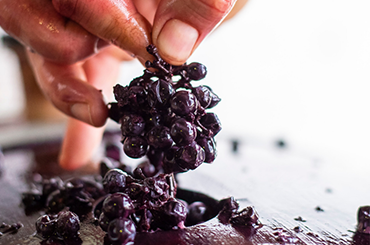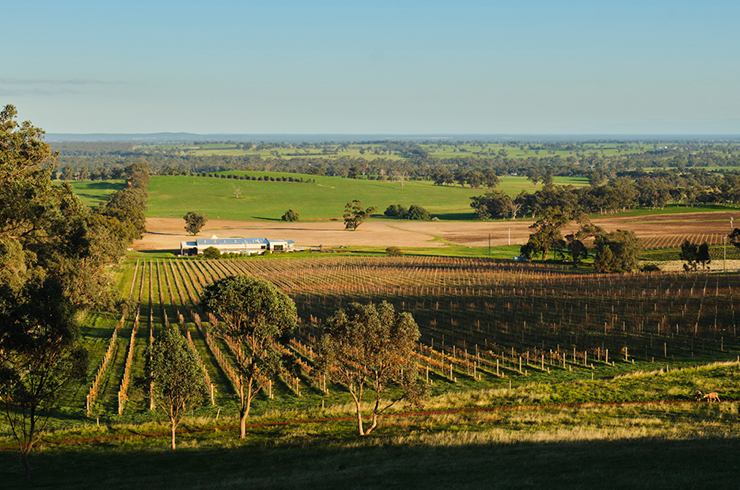By now you've probably heard about grenache's meteoric rise in popularity in Australia over the last few years. So why is grenache so popular? Grenache – or garnacha as it is known in Spain – has a long history in Australia, with it originally being used for fortified wines. Grenache thrives in hot and dry conditions, and does especially well in regions like McLaren Vale, and the Barossa and Clare Valleys.
Over the years the style of grenache in Australia has shifted, with modern grenache usually medium- to full-bodied, bright in colour with balanced tannins and medium acidity. When it comes to pairing food with grenache, it's all about finding dishes that will complement the spice in the wine. The three winemakers from Beresford, d'Arenberg and Serafino have some great suggestions below.
d'Arenberg winemaker Chester Osborn says, "A small panel of marketers and I were discussing ways to promote grenache – my suggestion was to wear a loud shirt in honour of grenache because it is loud and fun (if you know me, then you know I love a loud shirt!)." We like this suggestion.
But, if you don't have a loud shirt on hand, we suggest you get on board with International Grenache Day by drinking some delicious grenache on September 15. These three wines are a great place to start.
2023 Beresford Emblem Old Vine Blewitt Springs Grenache
Notes of strawberry jam, cherry, sour cherry, and dark plum taking the lead. Hints of fennel seed and a breath of mint, and clove in the background, add a subtle herbal note. The wine has a medium body with a mouthcoating tannin sensation that adds to the wine’s texture. Flavours mirror those discovered on the nose, with red plum, dark plum, and strawberry leading the way. A gentle feeling of warm spices, including cinnamon and clove is presented.Winemaker Chris Dix says: This grenache is fresh, bright and juicy. The wine’s character can be traced back to our very own 60+ year-old bush vine vineyard, which has two distinct grenache blocks. Adjacent to the Beresford House, the Block A vineyard was established in 1960 and boasts bush vines growing on their original rootstock. Moving to the eastern side, the Block B grenache vineyard, planted in 1965 is located in Blewitt Springs, home to some of the region’s oldest vines. Its unique micro-climate, together with a soil structure of Maslin sand over clay dates back 50 million years ago, resulting in the production of some of the finest fruits in the region.
H. How do you approach the process when it comes to this wine?
CD. 80 per cent destemming, 20 per cent whole bunch. Fermentation took place in an open fermenter, featuring a header board. To ensure even heat distribution and optimal aeration, we performed gentle pump-overs twice a day. A period of three to four days of skin maceration further elevates the wine’s character. Following fermentation, the wine found its home in large format puncheons ranging from 500 to 800 litres, four to six years old. Fined with vegetal protein. Vegan friendly.
H. Grenache is rising in popularity in Australia – why do you think this is, and what do you think the future of grenache is here?
CD. Grenache has been grown in Australia for a long time, and it is particularly suitable to the mediterranean climate in South Australia. Grenache can be made into a variety of different styles, from high alcohol, oak treated full body wine to carbonic, nouveau-style easy drinking red. Here in Australia, we are blessed with some of the oldest Grenache vine in the world, producing low yielding, high-quality fruit.
Best enjoyed: We recommend decanting for one hour prior to serving to enjoy the bursting bouquet. Serve in a Burgundy shape wine glass at 15–18°C and pair with confit duck with blood orange sauce.
RRP $35 | Drink to 2034 | beresfordestate.com.au | Shop this wine

2019 d'Arenberg The Ironstone Pressings Grenache Shiraz Mourvèdre
Bright medium–dark ruby. Lifted aromas of black cherry and fruits of the forest, with hints of mint and turned earth. The palate is bursting with rich blackberries, blackcurrants, and Dutch licorice. Brushings of thyme and subtle porcini mushroom sit on top of a precise acid line. The tannins are broad and supportive, with good restraint and enough power to support the waves of fruit. A complete wine with intensity and persistence.Winemaker Chester Osborn says: This wine is so aromatic, spicy and perfumed. The Ironstone Pressings is not heavy, fat or oily like overripe grenache can be. It’s fragrant, spicy and gritty, with a certain elegance and power in the length. The fragrance goes on and on for a long time, with great tannins to finish. Some would say the tannins are characteristic of Barolo, but this wine has more fruit and spice. I say it's better than Barolo.
H. How do you approach the process when it comes to this wine?
CO. The fruit used in The Ironstone Pressings is sourced from low-yielding grenache vines that were planted in 1912. The winemaking is very simple: whole berries started slow with a small amount of yeast and submerged cap. The grapes are foot-trodden and basket pressed. I specifically choose shiraz that looks like grenache to blend into The Ironstone Pressings; I’m looking for spice and fragrance, not heavy, solid, and earthy characters. The mourvèdre is sourced from the second-oldest mourvèdre vineyard in the world (planted in 1918), located on the d’Arenberg property.
H. Grenache is rising in popularity in Australia – why do you think this is, and what do you think the future of grenache is here?
CO. Grenache has been the most expensive grape variety in McLaren Vale for 4–5 years now, due to the demand. When I started making wine 40 years ago, grenache was herbal in nature and ripened a month later than it does now. Now grenache appears to have more fruit from the purple spectrum of characters to it, with less herbaceousness. It is such an amazing grape with fragrant, great length and bright, spicy tannins. People are starting to see it as a replacement for pinot noir, which is so expensive and sometimes not well-delivering. The earthiness, amazing fruit character of grenache and ageability make it such a great variety to work with.
Best enjoyed: The Ironstone Pressings is best enjoyed double-decanted an hour before drinking. This wine can be enjoyed on its own; however, it is ideally drunk with some amazing food. This wine is so versatile it can be paired with anything from lighter dishes to amazing spicy food.
RRP $78 | Drink to 2060+ | darenberg.com.au | Shop this wine

2022 Serafino Reserve Grenache
Medium bodied, with a long, even, bright palate. Super silky with spice, violets and plums. A fruit-forward style with beautiful complexity.Winemaker Brett Smith says: The varietal purity of this wine is what I love most. Amongst many subtle layers of aromatic complexity, the lifted grenache varietals simply glow and continue to linger with the fine, chalky tannins. It was the winner of the 2023 James Halliday Grenache Challenge.
H. How do you approach the process when it comes to this wine?
BS. This wine is a blend of multiple parcels made using a wide range of techniques in the hope that each parcel will add something unique to the blend. Earlier picked parcels are either fully destemmed to maximise bright varietals or may undergo partial carbonic maceration. Later picked parcels are selected from low cropping old vines which may spend significantly more time on skins to add textural complexity to the final wine.
H. Grenache is rising in popularity in Australia – why do you think this is, and what do you think the future of grenache is here?
BS. I think the rise in popularity in grenache is on a similar trend to the rise in quality of grenache wines in Australia. Grenache is now being made in many different styles and generally at lower alcohol levels, which is making these wines super versatile with different cuisines.
Best enjoyed: Serving temperature is very important for this style of grenache, with slightly lower temperatures (13–15°C) really enhancing the vibrancy of fruit and fine tannins. This grenache goes perfectly with butterflied and roasted quail with an orange honey glaze.
RRP $40 | Drink to 2027 | serafino.com.au | Shop this wine
Top image credit: Beresford.







